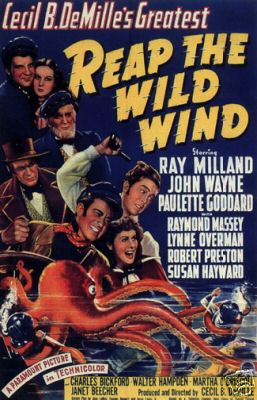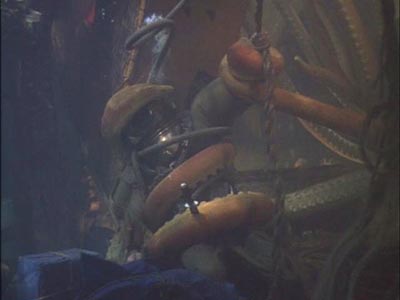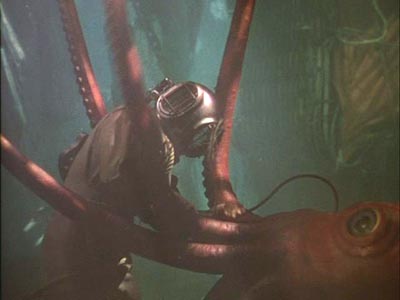Having ascertained who was the biggest movie star ever to fight a killer octopus onscreen, let’s move on to the nearly as interesting subsidiary question; Who was the Biggest Movie Star Ever to fight both a killer octopus and a killer giant squid onscreen. At this point most will ask, did Kirk Douglas ever fight a killer octopus in a movie, or James Mason, perhaps? Good guess, given the pair’s famous squid brawl in 20,000 League Beneath the Sea. But, in fact, the answer to that profound query is, in fact…John Wayne.

For several years before his bout with the GIANT INFLATABLE KILLER OCTOPUS!!!! as delineated above, Mr. Wayne had tussled with a giant squid in Reap the Wild Wind, and in glorious Technicolor, to boot. Indeed, I had conflated these two films myself for years, having never seen either one (I was more familiar, as are most, with Wayne’s later career, and was myself quite surprised when the issue presented itself).
While perusing Reap the Wild Wind, I found myself wishing I had watched it before seeing Wake of the Red Witch. While it would be unfair to call Red Witch an out and out remake of Wild Wind, it is clearly meant to emulate what must have been a very successful earlier picture for Wayne. The commonalities—Wayne playing a morally ambiguous sea captain who purposely wrecks his company’s ship for his own profit, a fight with a deadly cephalopod, a tragic love element, Wayne meeting his fate while traipsing through the respective wrecked ships in a deep sea diving suit—are too numerous and specific to be accidental. Even the meter of the films’ titles is the same.
Meanwhile, Reap the Wild Wind itself is clearly famed director Cecil B. DeMille’s answer to the then recent Gone with the Wind (1939). As Hollywood’s acclaimed Master of Spectacle, it must have chapped DeMille’s ass to have something else make Hollywood’s Greatest Epic. And while DeMille made several pictures that contest for the second place spot, such as Ben-Hur and The Ten Commandments, he never did top Gone with the Wind. No one has.
As such, this is a fairly gaudy Technicolor extravaganza, set in the years before the Civil War, and revolving around a gorgeous, headstrong Southern Belle who knows what she wants and isn’t going to let anyone stand in her way to get it. Significantly, this character, Loxi Claiborne, is played by Paulette Goddard, one of the actresses most often mentioned for the role of Scarlett O’Hara before Vivian Leigh was cast.
Sadly, neither the setting nor the film’s female center is anywhere close to Gone with the Wind‘s. The story revolves around a band of ‘salvagers’ in the dangerous waters off the Florida Keys, a vastly important shipping route at the time. In fact, these salvagers are pretty much outright pirates, causing the wrecks themselves so that they can abscond with the ships’ stores.
That’s a dramatic story, but doesn’t exactly have the scope of the Civil War. Although a crawl prologue and much dialogue throughout the film tries to sell that idea that this shipping lane is *so* vital that these pirates are imperiling the very existence of the nation…well, c’mon. That’s kind of a hard sell.
Meanwhile, it’s quite probably that at that time, only an adaptation of the nation’s most beloved novel could have possibly allowed for a screen character like Scarlet O’Hara. Especially since she remains, for all her scheming and backstabbing, a largely sympathetic character. At the end of the film, when the picture’s tragic denouement is reached, Loxi all but rends her hair and declares herself to be the author of It All. For my part, I wondered what she was talking about.
Yes, she does ‘lead on’ (although unlike Scarlet, we never get the idea she’d marry for anything like love) the Ray Milland character, but that only serves to kick things off. Meanwhile, for all her tomcat ways and very slight use of wiles, she never pulls the kind of truly cruel crap that Scarlet did, such as stealing her sister’s boyfriend after she learns he has the money she needs to affect her plans. This doesn’t mean the film is worthless, by any means; but as an answer to Gone with the Wind it falls laughably short.*
[*And, sadly, one of the few ways it perhaps surpasses, much less equals, GwtW is in its wince-inducing portrayal of blacks, especially with a Mammy character who’s a virtual (if lesser) clone of the one played by Hattie McDaniel. And for all the uncomfortable stereotyping in Gone, the fact remains that Mammy, Prissy, etc., still emerge as actual characters. Here the black character are much more stock.]Anyway, tomcat spitfire Loxi falls for rugged, manly captain Jack Stuart (Wayne), who in the beginning of the film loses his ship to the nefarious ‘salvager’ King Cutler (Raymond Massey). Unknown to Stuart, Cutler had a man aboard ship, who maneuvered the vessel on the reefs. Stuart is injured, and cared for by Loxi, who lives on the coast off the reefs, and whose own father is an honest salvager being driven out of business by King and King’s somewhat less malign brother, Dan (Robert Preston, oddly playing a hunky tough guy here). After all, it’s to beat a competitor to a sinking ship when the other guys knows exactly where and when said craft is going to sink.
This is a blow to Stuart’s career, especially since he had had dreams of commanding the company’s prestigious new steam ship, the Southern Cross. However, standing between him and the command, as he sees it, is the company’s apparently foppish lawyer, Steven Tolliver. Tolliver’s look and demeanor, from his insanely amok hairdo to his frou-frou clothes to his habit of ‘entertaining’ young ladies (if not the audience) with a simpering, excruciatingly bad but purportedly droll ventriloquism act (INFORMED ATTRIBUTE), performed with his annoying little lap dog—a literal one—well, in any other movie it would be apparent the guy was supposed to be gay.
Here, though, we will eventually learn that Tolliver is ALL MAN. Loxi, hoping to procure Tolliver’s favor for Stuart, allows the former to believe he has a shot with her, as he is (given that she’s the heroine) instantly smitten with her. Indeed, Tolliver is such a fair play guy that rather than use his position to crush Stuart’s career and remove him as a rival, he in fact does the opposite, and pushes for him to get the Southern Cross. Neither Stuart nor Loxi know that, though, and ultimately tragedy ensues after a bitter Stuart throws in with King Cutler to wreck the very ship he always wanted to command. Following that, Tolliver finds himself prosecuting King, while attempting to save Loxi grief, in maritime court. This eventually leads to the climax where a possibly murderous Stuart and the stalwart Tolliver head down to the wreck of the Southern Cross to examine the hold. Happily, they aren’t alone, and soon are confronted with a GIANT KILLER RUBBER SQUID!!!!
Will Stuart leave Tolliver to the mercies of the squid to save his own hide? Will he indeed murder Tolliver and blame it on the squid? Will he redeem himself with a noble death? Well, what do you think?




Bonus Squid Content. A-. As you can see from the stills, the squid is pretty bitching. The only flaw with it is that some of its moments are repetitious, although given that the beast is maneuvering within a ship’s hold, this is partly credible. The real issue, though, is that the squid appears not to be an inflatable jobbie, but a full mock-up, meaning that it probably weighed a significant amount. Because of that, only the tentacles could be moved about on wires, whereas the body was probably moved back on forth on a hidden track. Naturally, this rather limits the directions in which it can move. Still and all, though, it’s pretty fabulous. Not 20,000 Leagues Beneath the Sea fabulous, but as good as I’ve seen outside of that film. The color film also allows the squid to look very cool, as seen above.
This sequence also answered my question regarding Wake of the Red Witch. I had wondered why they would be silly enough to stick such a show-stopping sequence as a GIANT INFLATABLE KILLER OCTOPUS!!!! fight in the middle of the film. I mean, they must have known they’d have trouble topping that.
The answer is clear after seeing this earlier film. As this film ended with a giant squid fight, it would have been all but screaming ‘rip-off!’ to stage a similar climax in Red Witch. Indeed, both films already end with Wayne in an oldie diving suit perilously wandering the hold of the cargo ship he himself had captained and intentionally sunk. They clearly wanted to emulate Reap the Wild Wind here, but not quite so much as to anger audiences. That said, however, those audiences presumably must have loved the first film’s squid scene (why wouldn’t they?), and hence the Red Witch octopus fight. Just not, for obvious reasons, at the exact same spot in the film.
[Set include not only Wake of the Red Witch, but The Quiet Man, The Sands of Iwo Jima and Flying Tigers. Not bad for $20.]